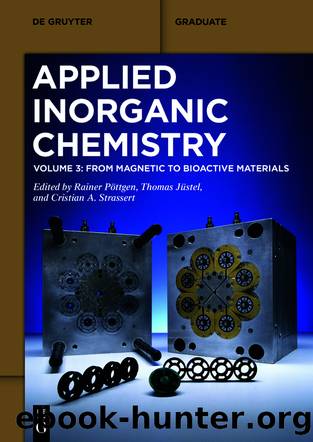From Magnetic to Bioactive Materials by Rainer Pöttgen Thomas Jüstel Cristian A. Strassert

Author:Rainer Pöttgen, Thomas Jüstel, Cristian A. Strassert
Language: eng
Format: epub
Publisher: De Gruyter
Published: 2022-04-27T10:58:31.663000+00:00
10.4.4.6âBoron nitride
α-Boron nitride is structurally comparable to graphite (therefore, also called white graphite), and consists of a planar, hexagonal crystal structure in layers. In powder form or as a surface coating, hexagonal boron nitride α-BN is often used as a release agent and lubricant in foundry technology due to its poor wettability with molten metals. In its cubic modification β-BN, it is used as cutting ceramic due to its high hardness, thermal conductivity and thermal stability [36]. The industrially used name CBN is derived from the initial letters in âCubic Boron Nitrideâ. CBN was first synthesized in 1957 and has been available on the European market since 1969. The ceramic bonds, which have been in use since 1982, made it possible for the first time to dress grinding tools economically. With a Knoop hardness of 45 GPa at room temperature, CBN is the second hardest known material after diamond (88 GPa). Due to the graphitization of diamond, which begins at 700 °C, it can only be used up to a maximum of 900 °C. CBN, on the other hand, can be used up to 1400 °C and is therefore the hardest known material above 900 °C. Since CBN does not contain carbon, it is suitable â unlike diamond â for machining hardened and unhardened steels containing carbon [35, 37].
Download
This site does not store any files on its server. We only index and link to content provided by other sites. Please contact the content providers to delete copyright contents if any and email us, we'll remove relevant links or contents immediately.
Alchemy and Alchemists by C. J. S. Thompson(3451)
The Elements by Theodore Gray(3000)
The Club by A.L. Brooks(2863)
How to Make Your Own Soap by Sally Hornsey(2830)
Drugs Unlimited by Mike Power(2545)
Quantitative and Pattern Recognition Analyses of Five Marker Compounds in Raphani Semen using High-Performance Liquid Chromatography by Unknown(2528)
Wheels of Life by Anodea Judith(2098)
Cracking the LSAT, 2012 Edition by Princeton Review(1887)
Cracking the Sat French Subject Test, 2013-2014 Edition by The Princeton Review(1829)
Perfume by Jean-Claude Ellena(1782)
The Flavor Matrix by James Briscione(1778)
The Cosmic Machine: The Science That Runs Our Universe and the Story Behind It by Scott Bembenek(1728)
MCAT Physics and Math Review by Princeton Review(1637)
1000 Multiple-Choice Questions in Organic Chemistry by Organic Chemistry Academy(1621)
The Thing Around Your Neck by Chimamanda Ngozi Adichie(1601)
Handbook of Modern Sensors by Jacob Fraden(1544)
Cracking the SAT Premium Edition with 6 Practice Tests, 2017 by Princeton Review(1539)
Synchrotron Light Sources and Free-Electron Lasers by Eberhard J. Jaeschke Shaukat Khan Jochen R. Schneider & Jerome B. Hastings(1525)
A is for Arsenic: The Poisons of Agatha Christie (Bloomsbury Sigma) by Kathryn Harkup(1507)
